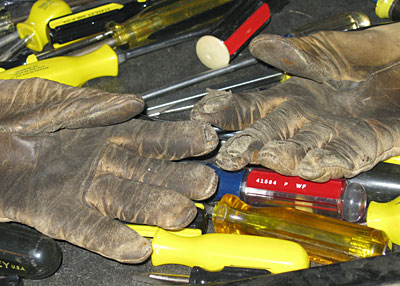Work gloves are life preservers for your hands
by Damien Andrews
The term ‘work gloves’ can be applied to many forms of hand protection. A doctor’s work gloves are customarily made of thin latex. A dishwasher’s work gloves are rubber gloves. A clown’s work gloves are white cotton. The work gloves we’ll be discussing in this article are the variety of gloves that are worn during physical work that frequently puts hands at risk of slight to serious injury.
Like almost everything else, work gloves have evolved considerably over the past fifty years. They are not only available in many more styles, but in many more materials, grades and sizes – each designed to perform best under specific circumstances. In the middle of the last century, work gloves were basically available in three sizes and about three grades of leather. Today’s work gloves are made of everything from leather and mesh metals to hi-tech synthetics and Kevlar.
For decades I only wore the Wells Lamont medium grade leather work gloves. These work gloves have been available since I was a kid. During countless trips to hardware stores to replace my worn out (and I do mean worn out – see the accompanying photo) gloves over the years, I got to watch as the work gloves selection grew from three or four pegs at the checkout, to vast displays with dozens of options.

An old pair of my work gloves clearly shows how much damage my gloves took and my hands didn’t. Wearing good work gloves just makes sense.
Finally, this old dog learned a new trick. I broke down and bought a pair of Wells Lamont style #3210 in grain deerskin. This model has a spandex back and a hook and loop wrist closure with elastic in it. It also has a padded knuckle insert and reinforced fingertips. While wearing these work gloves, I can actually pick up a #6 finishing nail or get my carpenter’s pencil from my deep side pocket. Of course I still bought a new pair of my old standbys – and wouldn’t be without them.
Shortly after discovering the functionality of my new work gloves, I started thinking maybe these ‘new fangled gloves’ weren’t so bad after all. This started me down the road of discovering other useful work gloves.
My next new pair of work gloves was from Texas America Safety Company. This gauntlet-style glove is designed for high temperature use and is spark and flame resistant. Item 214-LWL – 22 Oz High Temp Glove with Leather Palm (14 inch). I use them to tend to my wood stove and for light duty welding. They’re amazing, as are the work gloves similar to these in specification and application.
Some other work gloves that might be worth considering, depending on how you put your hands in harm’s way, include high visibility gloves, cold weather work gloves, non-conductive gloves and cut resistant gloves. If you haven’t been wearing work gloves because you thought they didn’t make what you needed, please do look again.
Admittedly, wearing work gloves can be a hassle at times. But the rewards for wearing a proper work glove are well worth any minor inconvenience. If you get a pair of work gloves and use them, they WILL wear out. Imagine the wear and tear and cuts and scrapes those tough gloves absorbed – and your hands and fingers didn’t. It’s much better to throw away a pair of ripped worked gloves than spend 6-weeks letting your stitched up hand heal.
Whether or not you depend on hard work with your hands for a living, work gloves should be in your tool box – and on your hands when you need them. And since today’s work gloves come in a full array of types and at nominal cost, you really don’t have any reason not to have at least one pair. Remember: an ounce of prevention is worth a pound of cure.





